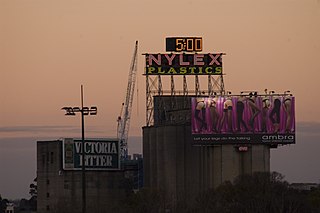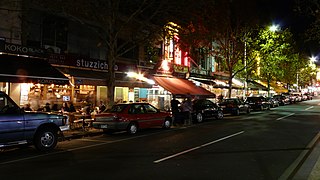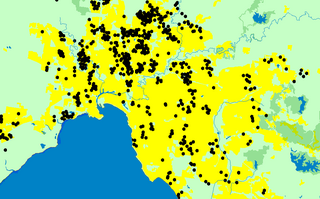
Lygon Street is located in Melbourne, Victoria, Australia, running through the inner northern suburbs of Carlton, Carlton North, Princes Hill and Brunswick East. Lygon Street is synonymous with the Italian community of Melbourne, forming the nexus point of Little Italy. It is home to many Italian restaurants and alfresco cafés.

Brunswick is an inner-city suburb in Melbourne, Victoria, Australia, 5 km (3.1 mi) north of Melbourne's Central Business District, located within the City of Merri-bek local government area. Brunswick recorded a population of 24,896 at the 2021 census.

Carlton is an inner-city suburb in Melbourne, Victoria, Australia, 3 km north of Melbourne's Central Business District, located within the City of Melbourne local government area. Carlton recorded a population of 16,055 at the 2021 census.

Nicholson Street is a street in inner Melbourne. It is named after William Nicholson, then member of the Legislative Council, and later Premier of Victoria from 1859 to 1860.

Carlton North is an inner-city suburb in Melbourne, Victoria, Australia, 4 km (2.5 mi) north of Melbourne's Central Business District, located within the Cities of Melbourne and Yarra local government areas. Carlton North recorded a population of 6,177 at the 2021 census.

Brunswick East is an inner-city suburb in Melbourne, Victoria, Australia, 5 km (3.1 mi) north of Melbourne's Central Business District, located within the City of Merri-bek local government area. Brunswick East recorded a population of 13,279 at the 2021 census.

The Nylex Clock is heritage listed as an iconic feature of Melbourne and is considered part of the popular culture of the city. It is neon sign sitting atop malting storage silos in the suburb of Cremorne, Victoria, Australia. It is located adjacent to the northern bank of the Yarra River and the Monash Freeway and displays the time and temperature alternately. The text also alternates displaying the words 'Nylex Plastics' that changes to 'Nylex Every Time!'. It is visible from many parts of Melbourne, particularly the Melbourne Cricket Ground. This linkage is referred to in the song "Leaps and Bounds" by musician Paul Kelly and was once climbed by Brisbane-based activists Freshellen Frew, Ag Heard and several other Melbourne-based activists.

The Skipping Girl Sign or Skipping Girl Vinegar Sign, colloquially known as Little Audrey is an historic animated neon sign in the inner suburb of Abbotsford, Melbourne, and was possibly the first animated neon sign in Australia when first erected in 1936. It advertised the Skipping Girl Vinegar brand, and was placed on top of the factory at 627 Victoria Street, Abbotsford. Removed in 1968, a reproduction was placed on a nearby factory at 651 Victoria Street in 1970 following a public outcry.

The Pelaco Sign is a heritage-listed neon sign located in the inner Melbourne suburb of Richmond. It was erected in 1939 as an advertisement for local shirt manufacturer Pelaco.

The Royal Melbourne Hospital (RMH), located in Parkville, Victoria, an inner suburb of Melbourne, is one of Australia's leading public hospitals. It is a major teaching hospital for tertiary health care with a reputation in clinical research. The hospital is managed as part of Melbourne Health which comprises the Royal Melbourne Hospital, North West Dialysis Service and North Western Mental Health. The Melbourne Health Chief Executive is Christine Kilpatrick AO.

Princes Hill is an inner-city suburb in Melbourne, Victoria, Australia, 3 km (1.9 mi) north of Melbourne's Central Business District, located within the City of Yarra local government area. Princes Hill recorded a population of 2,005 at the 2021 census.
The Carlton Crew is a criminal organisation based in Melbourne, Victoria, Australia, which was formed in the late 1970s and named after the Melbourne suburb in which it is based, Lygon Street, Carlton, commonly called "Little Italy". The organisation was a fierce rival to the Honoured Society and the Calabrese Family, both of which were Calabrian 'Ndrangheta groups also based in Melbourne, and were additionally allies of the mostly Irish Moran family. The Carlton Crew had a strong role in the infamous Melbourne gangland killings.

Little Italy in Victoria, Australia, is a "Little Italy" cultural precinct of the Italian community of Melbourne. It is situated along Lygon Street in the inner-Melbourne suburb of Carlton.

Toto's Pizza House (Toto's) was the first pizzeria established in Melbourne, Australia, now a small chain of Pizza stores. Toto's opened for business on 7 July 1961 in Lygon Street, Carlton, Victoria, where the business remained until closing in 2020 due to Melbourne’s COVID lockdowns. Toto's was originally owned by Salvatore Della Bruna, who operated the business in partnership with Franco Fera and in 1968 with Silvio Tuli and Salvatore Mercogliano. Successful, and well respected, business man Mario Bandera also played a large part. In 1983 the business was purchased by the most recent owner and Managing Director, Sami Mazloum.

Nino Borsari was an Italian cyclist who won a gold medal in the 4000 metres team pursuit event at the 1932 Summer Olympics.
Dudley Street is a main street in the Melbourne central business district, linking the northern Docklands district to the north-western corner of the Melbourne CBD. Dudley Street is possibly named after the Governor General from 1908 to 1911, the Second Earl of Dudley, William Humble Ward.

The Italian community of Melbourne is the second largest ethnic group in Greater Melbourne, Victoria (Australia), second to the Anglo-Celtic Australians ethnic group. The 2011 Census counted that of the 185,402 residents that were born in Italy who live in Australia, 68,823 lived in Melbourne, which was the highest percentage of the country at 37.1%. The same could be said for the total Australian population of Italian ancestry, with 279,112 of the 916,121 (30.4%) listed as Melbourne residents, which is the highest Italian population in Australia and the Oceanic continent per city.
Grattan Street is a major street in Melbourne, Australia.
Ermin Smrekar (FAIA) was an Italian born Australian architect who practiced in Melbourne, Australia from the 1960s to the 1990s. He is known for designing outside the mainstream of Australian architecture in the period, his individual approach drew from organic architecture, angular and circular geometries, as well as historical sources, to create sometimes bold sculptural forms.

Pellegrini's Espresso Bar is a café on Bourke Street in Melbourne, Australia, described as "one of Melbourne's most iconic destinations, in a city that prides itself on coffee and fine food". The café was established in 1954 by Leo and Vildo Pellegrini - brothers and migrants from Italy. The brothers had worked at Florentino's, a popular Italian restaurant on Bourke Street before establishing their own coffee bar nearby. The bar is claimed to be the first in Melbourne to use an espresso machine, although many cafés in the Italian-Australian neighbourhood of Lygon Street in Carlton acquired machines at around the same time.















